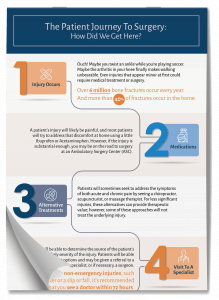KNEE ARTHROSCOPY
The knee is the largest joint in the body–and among the most complex. The connections of bones, cartilage, tendons, ligaments, and meniscus all keep your knee functioning properly and grant you a wide range of movement. But the damage to any portion of your knee can significantly reduce your mobility–and your comfort.
That’s why knee arthroscopy has become a critical procedure for orthopedic care. This minimally invasive surgery allows your orthopedic team to see inside your knee using a tiny fiber-optic camera. By making only keyhole-sized incisions, your surgeon can then effect repairs to some knee injuries and ailments. The small incisions mean a faster recovery with less pain.

What Happens During Knee Arthroscopy?
Depending on your pain level, preferences, and condition, a knee arthroscopy may be performed under general, local, or regional anesthetic. Usually, this procedure is performed on an outpatient basis, so you’ll return home the same day. Many patients elect to undergo knee arthroscopy in an ambulatory surgery center setting, bypassing the hospital completely.
Once anesthesia is administered, your orthopedic surgeon will make a small incision (incisions made during knee arthroscopy are typically referred to as “buttonhole” or “keyhole” sized). Once the incision is made:
- Your surgeon will insert a tiny camera attached to the end of a long fiber-optic tube. This is called an arthroscope.
- Using the camera, your surgeon will inspect the damage around your knee.
- Once your surgeon visually inspects your knee, your orthopedic team may be able to make repairs. To do so, additional tiny incisions may be made in the knee. This allows miniaturized tools to be inserted to perform tasks.
- Repairs may consist of cutting, suturing, or removing small portions of tissue, anchoring stitches to specific locations, or engaging in a meniscus repair.
- Once the required corrections have been made to your knee, the surgical team will remove the tools and close up the incisions.
Technically, knee arthroscopy is performed as elective surgery; but this doesn’t mean the pain or discomfort you feel isn’t acute and urgent. “Elective” simply means that you have the option to decide when the surgery is performed (in other words, it’s not an emergency).
There are risks and complications that can happen due to knee arthroscopy. Infections, blood clots, and knee stiffness rarely occur–and the overall complication rate of knee arthroscopy is quite low. But you should still talk to your provider about assessing your personal risks for this procedure.
Am I a Good Candidate for Knee Arthroscopy?
So, who should get knee arthroscopy done? In general, knee arthroscopy is a good procedure for anyone who has experienced knee damage. For some, that damage was likely caused by an injury or trauma. For others, the damage may be due to overuse or wear and tear.
For athletes, knee arthroscopy may be used to repair injuries (such as ACL tears), allowing the athlete to return to competitive levels of performance.
Your orthopedic team will likely attempt non-surgical solutions first. If those solutions do not yield positive results, you may be a good candidate for knee arthroscopy.
In general, candidates for knee arthroscopy will:
- Be generally healthy enough for surgery
- Be experiencing pain or inflammation of the knee
- Have discussed all of their treatment options with their orthopedic team
- Understand the possible risks and complications of the procedure
What Conditions Does Knee Arthroscopy Address?
Knee arthroscopy can be used to:
- Treat a torn meniscus via removal or repair
- Remove infected tissue or treat knee sepsis
- Remove inflamed tissue
- Remove bone or cartilage that is loose or free-floating
- Reconstruct an anterior cruciate ligament (ACL) after it has been torn
- Address issues with the kneecap
This list is not exhaustive. If you have knee pain, you should talk to your orthopedic surgeon about whether knee arthroscopy is right for you. Even in cases where the procedure is not suited for repairing damage, knee arthroscopy can still give your orthopedic team a much clearer image of your injury, leading to improved overall treatment.
Recovery for Knee Arthroscopy
Because of its minimally invasive approach, recovery from knee arthroscopy is significantly shorter than more traditional knee surgeries. Most people who undergo knee arthroscopy are able to return to most normal activity within a month or two.
However, your recovery time could vary significantly depending on the scope of work performed. In general, you should expect to avoid putting weight on your operated leg for a period of time. Your surgeon will tell you when it’s safe to begin walking or putting weight on your leg.
Your surgical team will also tell you when you can expect to drive or go back to work. Usually, these time periods are measured in a matter of weeks. But it’s important to keep in mind that your recovery period will vary based on the severity of your injury: the more trauma your knee experienced, the longer you can expect your recovery to be.
Physical Therapy
A valuable part of knee arthroscopy recovery is often rehabilitative physical therapy. Your surgical team may recommend you attend physical therapy sessions fairly quickly into your recovery. This will help you regain strength, flexibility, and mobility. Physical therapy is a critical step in ensuring that your procedure is successful.
Talk to Your Orthopedic Surgeon Today
If you’re experiencing knee pain or discomfort, talk to your orthopedic surgeon about whether knee arthroscopy may be a good fit for you. With the right approach, you can get your mobility back–with the minimized pain and discomfort that comes from this minimally invasive procedure.
Because knee arthroscopy is an outpatient procedure, some patients opt to undergo this operation in an ambulatory surgery center (ASC). For many patients, ASCs are popular because they offer a more comfortable and convenient venue for your surgery. If you want to have your knee arthroscopy performed in a high-tech and friendly setting, talk to your orthopedic team about having your knee arthroscopy performed at an ambulatory surgery center.
The Patient Journey to Surgery: How Did We Get Here?
Everyone’s journey will be different, but the basic steps will often be similar. Discover where you are in the process–and what comes next. Download our resource and find out how where you are on your journey to surgery.







